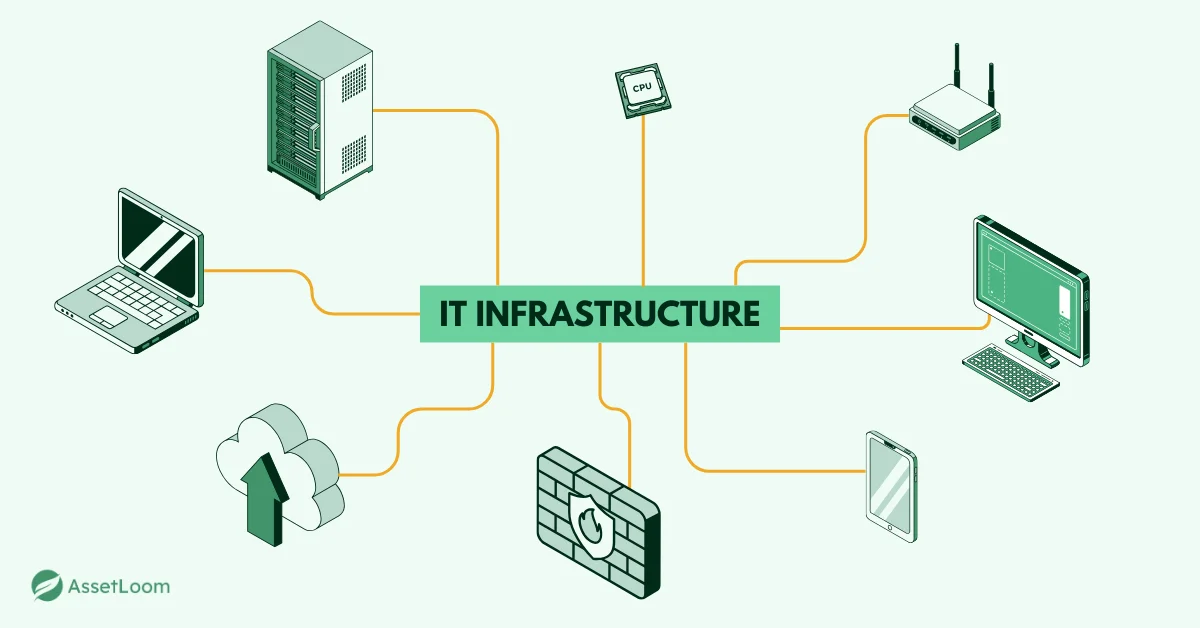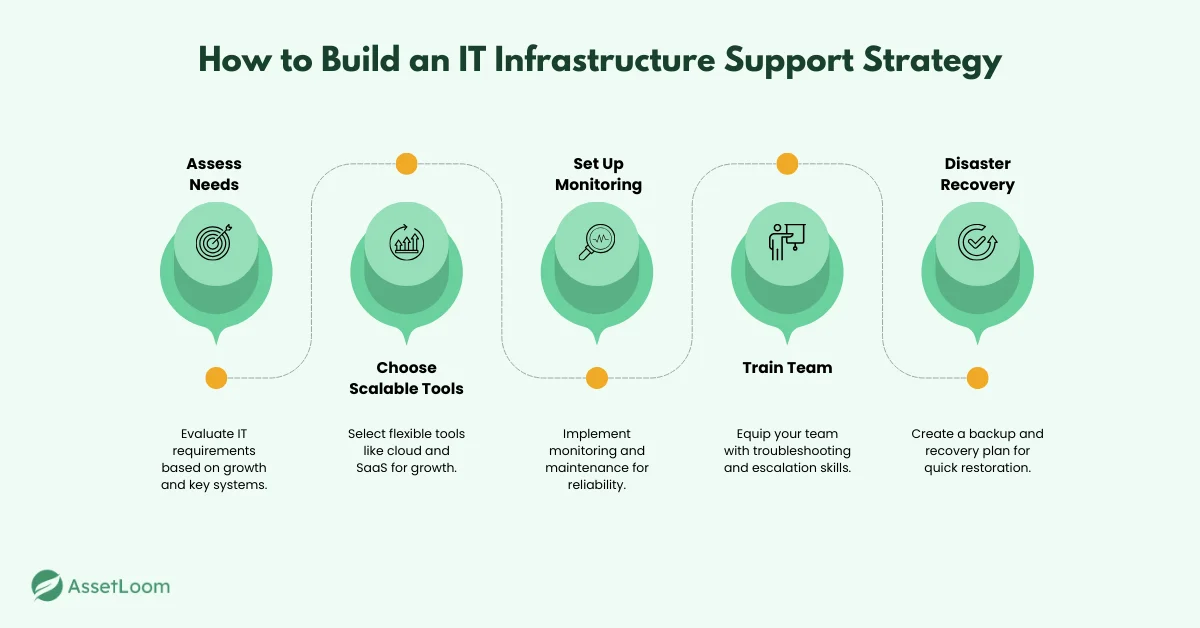IT Infrastructure Support: A General Overview for New and Growing Businesses
Learn what IT Infrastructure Support is and how it helps new businesses scale, secure systems, and improve efficiency.
For new and growing businesses, managing IT systems can quickly become overwhelming. As your company scales, the pressure to keep everything running smoothly increases - systems may slow down, security risks rise, and even the smallest disruptions can lead to costly downtime. Without a solid IT infrastructure support strategy in place, these challenges can stunt growth and hinder productivity.
But the good news? Effective IT infrastructure support can address these issues, ensuring that your systems are secure, scalable, and running at peak performance. In this blog, we'll explore what IT infrastructure support is, why it’s crucial for your business’s success, and how to develop a strategy that meets your growing needs.
What is IT Infrastructure?
Before diving into IT infrastructure support, it’s important to understand what IT infrastructure actually is. In simple terms, IT infrastructure refers to the collection of physical and virtual resources that are necessary for running an organization’s IT environment. It includes everything from servers and storage devices to software, networks, and cloud services.
These components work together to ensure the smooth operation of your business systems, allowing you to manage data, run applications, and connect with customers effectively. As businesses grow, their IT infrastructure needs evolve, making it essential to have the right systems in place that can scale with increasing demands.
Some key components of IT infrastructure include:
- Hardware: Servers, storage devices, and networking equipment.
- Software: Operating systems, databases, and business applications.
- Networking: Routers, switches, and firewalls to ensure connectivity.
- Cloud Services: Virtualized environments and cloud platforms for scalability.
- Security: Measures like firewalls, encryption, and backup systems to protect data.
Additionally, businesses often rely on IT Asset Management (ITAM) to track and manage their IT assets, ensuring that hardware and software are properly maintained and compliant with industry standards. By understanding IT infrastructure, businesses can make better decisions when it comes to maintaining and supporting these systems as they expand.

What is IT Infrastructure Support?
IT infrastructure support refers to the services and strategies that ensure your IT systems run smoothly and securely. It includes the ongoing management of hardware, software, networks, and security to prevent disruptions and optimize performance.
Key tasks in IT infrastructure support include:
- Monitoring: Tracking system health and spotting issues early.
- Troubleshooting: Resolving hardware, software, or network problems.
- Upgrades: Installing updates and patches to improve performance and security.
- Security: Protecting infrastructure from cyber threats through firewalls, encryption, and audits.
- Backup and Recovery: Ensuring critical data is backed up and can be restored if needed.
The Key Components of IT Infrastructure Support
- Hardware Support: Maintaining physical devices like servers, computers, and networking hardware.
- Software Support: Keeping operating systems and applications up to date.
- Network Support: Ensuring your network is secure and can handle data traffic efficiently.
- Cloud Support: Managing cloud services and ensuring optimal performance.
- Security Support: Protecting infrastructure with robust security measures to prevent breaches.
Why It’s Important: Proper IT infrastructure support helps businesses minimize downtime, improve security, and ensure systems are always ready to support growth.
Why IT Infrastructure Support is Critical for New and Growing Businesses
For new and growing businesses, IT infrastructure support is essential to prevent disruptions like downtime, security breaches, and system slowdowns.
Effective IT support ensures your infrastructure can scale as your business grows, avoiding performance bottlenecks. It also helps control costs by addressing issues early, before they become expensive problems. Regular support keeps your systems secure, safeguarding sensitive data and ensuring compliance with regulations.
Additionally, IT support enhances operational efficiency, minimizing disruptions and optimizing system performance, which allows your team to focus on what matters most.
In short, IT infrastructure support is critical for driving growth, maintaining security, and keeping your business running smoothly.
How to Build an IT Infrastructure Support Strategy
Creating an effective IT infrastructure support strategy is key to maintaining system reliability, security, and scalability as your business grows. Follow these detailed, actionable steps to ensure your IT systems can handle both present demands and future growth.
Step 1: Assess Your Business Needs
Begin by understanding your business’s current and future IT requirements. This includes evaluating your company size, industry, and growth goals. Knowing your business’s needs helps prioritize what requires immediate attention and where your IT infrastructure can grow alongside your business.
Start by identifying the critical systems and processes that rely heavily on IT, such as customer data management, sales platforms, or supply chain tracking. This will help you allocate resources more effectively.
Example: A growing online retailer might find that their website’s server performance is becoming slow during peak hours. This signals the need for scalable cloud services that can handle increased web traffic during high-demand periods, like seasonal sales.
Step 2: Choose Scalable Tools and Resources
Choose IT tools, systems, and platforms that are flexible enough to grow with your business. Scalable resources like cloud storage, virtualization, and software-as-a-service (SaaS) solutions can easily expand as your business’s needs evolve.
When selecting new tools, ensure they have the ability to scale both in terms of data and users. For example, you might start with a basic CRM system, but as your team grows, you may need a more robust solution like Salesforce, which can scale to meet the demands of a growing sales team and customer base.
Example: Start with cloud solutions like Google Drive or Dropbox for file storage. As you accumulate more data, migrate to scalable enterprise cloud services such as Microsoft Azure or AWS, which offer more storage capacity and better integration with other tools.
Step 3: Establish Clear Maintenance and Monitoring Processes
Ongoing maintenance and proactive monitoring are essential to keeping your infrastructure running smoothly. Set up regular monitoring of critical systems like servers, network devices, and security protocols to catch issues early. Tools like Nagios, Zabbix, or SolarWinds can automate system monitoring, sending alerts when performance dips or problems arise.
Implement regular maintenance schedules, including software updates, hardware checks, and system backups. Consider automating processes where possible to reduce the risk of human error and ensure consistent performance.
Example: Schedule weekly server health checks to monitor storage capacity and CPU usage, ensuring your systems can handle increased traffic. Automate daily backups to secure data and reduce the risk of data loss during system failures.
Step 4: Train Your Team and Develop Internal Processes
A well-trained team is essential to effectively support your IT infrastructure. Provide training on the systems you use, basic troubleshooting, and how to escalate issues. Training your team to handle common issues on their own can reduce downtime and reliance on external support.
Additionally, define clear internal processes for reporting and escalating IT problems. This ensures that minor issues are dealt with quickly and that critical problems are prioritized and handled by the appropriate team members.
Example: Train employees on how to reset passwords, use collaboration tools effectively, and troubleshoot connectivity issues before reaching out to IT support. Create an internal process for escalating more serious issues, such as system outages, to the right teams.
Step 5: Implement a Disaster Recovery Plan
A disaster recovery plan is essential to ensure that your business can quickly bounce back from unexpected disruptions like hardware failures, cyberattacks, or data breaches. The plan should include data backups, system restoration procedures, and a designated recovery team.
Implement regular data backups that cover not only critical business files but also configurations, software, and system settings. Store backups in multiple locations, including both on-premises and cloud-based solutions, to mitigate risk.
Example: Schedule daily backups for critical business data, and test the restoration process monthly to ensure quick recovery during an actual event. Ensure your disaster recovery plan includes a clear communication protocol so that team members know who to contact and what actions to take in the event of a disaster.
By following these steps and integrating proactive strategies into your IT infrastructure support plan, your business will be well-positioned to handle growth, minimize downtime, and maintain a secure, efficient IT environment.

Best Practices for IT Infrastructure Support in Growing Businesses
To ensure your IT systems remain secure, efficient, and scalable, follow these best practices:
- Regular System Audits: Conduct audits to identify outdated systems, security risks, and underused resources, ensuring everything is optimized and current.
- Utilize a Configuration Management Database (CMDB): Maintain a CMDB to track and manage IT assets and configurations, improving troubleshooting, resource management, and planning.
- Leverage Automation Tools: Automate routine tasks like software updates, backups, and security scans to reduce manual effort and ensure consistency.
- Invest in Scalable Solutions: Choose flexible, scalable tools and infrastructure solutions that can grow with your business, ensuring future adaptability.
- Implement Robust Security Measures: Adopt a multi-layered security approach, including firewalls, encryption, and regular audits, to protect your IT infrastructure.
- Document and Standardize IT Processes: Keep clear documentation of IT policies and procedures to ensure consistency and quick problem resolution across your team.
- Continuously Monitor IT Performance: Use monitoring tools to track system health, network traffic, and application performance, enabling proactive issue resolution.
Read also: How to Use Software Monitoring Software to Detect and Resolve System Issues
IT Infrastructure Support as a Key to Business Success
As your business grows, ensuring that your IT infrastructure is properly supported becomes increasingly important. Effective IT infrastructure support provides the foundation for scalability, security, and operational efficiency, enabling your business to adapt and thrive in a fast-paced digital world.
By following the steps and best practices outlined in this blog, you can build a robust IT infrastructure support strategy that ensures your systems are not only secure and reliable but also ready for the challenges and opportunities that come with growth.
Investing in IT infrastructure support isn’t just about keeping systems running; it’s about creating a solid foundation for your business’s long-term success.

Related Blogs
Subscribe for Expert Tips and Updates
Receive the latest news from AssetLoom. right in your inbox

